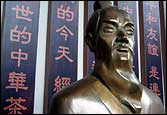 |
 |
|
|
|
||
|
TANG DYNASTY (618-907) It was during the Tang dynasty in China that the most famous of the world's tea books appeared: the Cha Jing ("Tea Scripture") of Lu Yu (728-804), a poet and scholar associated with the imperial court, then located in Hangzhou.  Lu Yu & the Cha Jing Modern Sculpture, China National Tea Museum, Hangzhou Lu's book presents a fascinating record of the highly evolved tea culture of his day and a compendium of its history up until that point. As one may expect, tea of the Tang period was quite a different affair from what we know today. Lu describes the entire process in detail - from harvest through processing to drinking. After plucking (preferably from wild mountain tea trees), the leaves are steamed, pounded, and shaped into cakes. To brew the tea, Lu explains, the cured tea cake must first be roasted over a fire to soften it and then wrapped tightly until cool to retain its fragrance.  Tang Daynasty Tea Grinder China National Tea Museum, Hangzhou Next, the tea is ground with a roller, and boiled. Lu suggests adding only salt to the brew, noting that it is still a common practice to boil tea in a medicinal brew with ginger, dates, peppermint, etc. "Drinks like that", he says, "are no more than the swill of gutters and ditches" (Carpenter trans., p. 116). Finally, the frothy brew is ladled into bowls - preferably with a blue/green glaze to enhance the color of the tea. A significant feature of the tea cake described in the Cha Jing is the hole bored in the middle with an awl during manufacture. The purpose was two-fold: first the hole allowed the cake to be strung up to dry after processing, and further, it facilitated the transport of the tea (tied together in bundles) from its place of origin throughout China and abroad as an article of trade. By the time of the eighth century, when Lu was writing, tea consumption had become so widespread, he remarks, that "it is immersed in our customs and flourishes in the present dynasty both north and south... [I]t is the common drink of every household." (p. 116) (PREVIOUS) - (NEXT) |
||